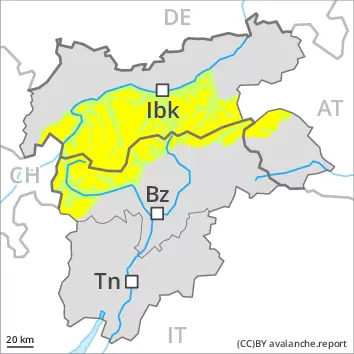
Danger level
 | 2200m |
|  |
|  |

Caution is to be exercised in particular on very steep slopes at high altitudes and in high Alpine regions at transitions from a shallow to a deep snowpack.
Avalanches can in isolated cases be released in the weakly bonded old snow, in particular by large additional loads. This applies especially on shady slopes, as well as adjacent to ridgelines above approximately 2200 m. Caution is to be exercised in particular on very steep slopes at transitions from a shallow to a deep snowpack, when entering gullies and bowls for example. Such avalanche prone locations are difficult to recognise. Mostly avalanches are medium-sized.
In addition the fresh wind slabs of the last few days at elevated altitudes are prone to triggering in isolated cases still. Caution is to be exercised in particular on very steep shady slopes above approximately 2400 m, as well as adjacent to ridgelines in high Alpine regions. The wind slabs are clearly recognisable to the trained eye.
In addition individual gliding avalanches are possible, in particular in the north.
Snowpack
dp.7: snow-poor zones in snow-rich surrounding
dp.6: cold, loose snow and wind
Individual weak layers exist in the centre of the snowpack, especially in little used terrain on very steep shady slopes above approximately 2200 m, but in isolated cases also in areas where the snow cover is rather shallow adjacent to ridgelines at high altitudes and in high Alpine regions. Along the border with Switzerland and in the Schober Mountains the snowpack is more prone to triggering.
As a consequence of the occasionally strong wind, snow drift accumulations formed. They are mostly small and unlikely to be released now.
Tendency
A quite favourable avalanche situation will be encountered over a wide area.


